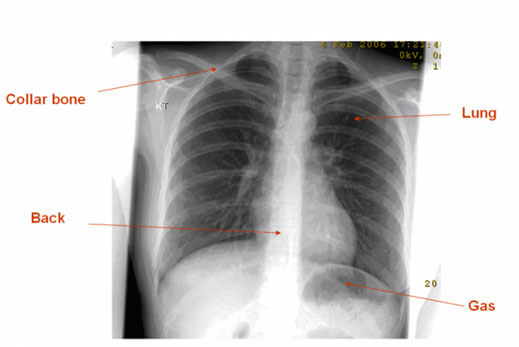Patient Services:
Digital X-Ray
What is a Digital X-Ray?
Radiography is the imaging of body structures using X-rays. X-rays are a form of radiation, similar to ordinary visible light, radio waves and microwaves. X-rays have a very high energy level that allows the beam to pass through the body and create an image or picture on a film, or screen behind the patient. South East Radiology has invested in the latest low dose Digital technology which greatly reduces the amount of radiation required to produce a high-quality radiograph.
Plain X-rays are the simplest form of medical imaging that use x-rays. Images are created by different X-radiation absorption by parts in the body. A dense structure, such as bone, absorbs a high percentage of the X-ray beam (which appears light grey on the image), whereas low-density structures, such as soft tissues, absorb a small percentage (which appears dark grey on the image).
The body has many different structures of varying densities and this difference creates a picture or image (see Figure 1).

Figure 1: Chest X-ray. Bone (collar bone and back) appear light grey. Air (lungs and stomach gas) appears dark grey.
Why would my doctor refer me for an X-Ray?
An X-ray examination is simple, quick and readily available at almost all radiology facilities. X-ray imaging is used to help diagnose both disease and injury, such as pneumonia, heart failure, bone fractures or infections, arthritis, different types of cancer, blockage of the bowel, collapsed lung and so on.
Therefore, your doctor might refer you for an X-ray if it is believed that an image of a part of your body could help find the cause of your symptoms and determine treatment.
X-ray is fast and easy, and accessible, and it is also particularly useful in emergency diagnosis and treatment.
How do I prepare for a Digital X-Ray?
No specific preparation is required for a plain X-ray.
It is important that you tell your own doctor and staff at the radiology facility where you are having the X-ray if there is any chance you might be pregnant.
This is important information, as it will make a difference in the way the X-ray is carried out or a different test altogether might be required. Your safety and that of your unborn child is the number one priority.
You will usually be given a gown to wear, as some clothing items, or pocket contents can make it difficult to see the images clearly, or mimic some pathology presentations.
You might also need to remove certain items, such as watches, necklaces and some types of clothing that contain metal objects, such as zips or buttons.
If you are attending a follow-up X-ray to assess the progress of an injury or illness, you need to take any previous X-rays you may have with you so the radiologist who will send a report to your own doctor can compare the new X-ray with the old one and see if there have been any recent changes.
At SER, we store all of our patient’s prior imaging for several years electronically, so your prior imaging is always available for comparison.
Who does the Radiograph (x-ray)?
A radiographer or medical imaging technologist is a trained health professional who carries out diagnostic radiography.
The radiologist is a specialist medical doctor who reviews and interprets the images and provides a written report of the test to your referring doctor, specialist or allied health worker.
What happens during a Digital X-Ray and how long will it take?
The radiographer who will carry out the X-ray will explain the procedure to you. The number of parts of your body being examined and type of pathology or injury suspected, will determine the number of X-rays to be taken.
The area being examined needs to be viewed from multiple directions to obtain enough information to make the diagnosis. This may require you to move into different positions (standing, sitting, lying down) during the test. Your mobility also has an impact on speed of examination. Generally, it only usually takes between 10- 15 minutes for an entire X-ray procedure.
It is important that you stay completely still when the radiographer instructs you to, as any movement might create a blurred image which would need to be repeated. Sometimes additional images need to be taken to better visualise the region, or to help the radiologist to make a diagnosis. There is no need for concern as it is quite common.
After the X-rays are completed, the radiographer will electronically process each X-ray and check the results for quality prior to completing the examination. The radiographer will provide further instruction for you when the procedure is finished.
The radiologist then carefully assesses the images, makes a diagnosis and produces a written report on the findings. This report is sent to your doctor who referred you for the test.
If you are bringing a child for an X-ray, you might be asked to help in settling or keeping the child in the correct position for the test. If you are asked to remain in the X-ray room, the radiographer will take all possible steps to ensure that you are not exposed to any X-rays.
Are there any after effects of a Digital X-Ray?
You will not feel anything while the X-ray is being taken or afterwards.
What are the risks of a Digital X-Ray?
Generally, the benefit of the X-ray procedure is far more important than the small estimated risk of the effects of radiation. At the radiation dose levels that are used in diagnostic radiography, there is little or no evidence of health effects (for further information see Inside Radiology: Radiation risk of medical imaging for adults and children).
The type of radiation used in X-rays is called ionising radiation. Medical research has been unable to establish conclusively that there are significant effects for patients exposed to ionising radiation at the doses used in diagnostic X-ray imaging.
Radiographers are trained to use the smallest possible amount of X-rays required to produce a satisfactory image.
South East Radiology has invested in the latest low dose Digital technology which greatly reduces the amount of radiation required to produce a high-quality radiograph.
When can I expect the results of my Digital X-Ray?
The time that it takes your doctor to receive a written report on the test or procedure you have had will vary, depending on:
- the urgency with which the result is needed;
- the complexity of the examination;
- whether more information is needed from your doctor before the examination can be interpreted by the specialist;
- whether you have had previous X-rays that need to be compared with this new test or procedure
- SER will have x-ray results to your referring doctor within 24 hours of examination.

